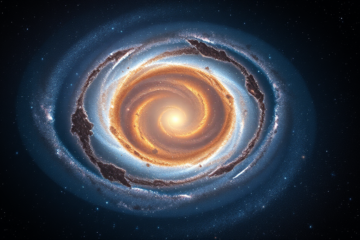Dark Energy and the Future of the Big Crunch
Dark Energy, which makes up about 70% of the universe, plays a crucial role in its current expansion.
In this article, we will explore the intriguing possibility that the universe will begin to contract in approximately 7 billion years, leading to a catastrophic collapse known as the Big Crunch.
We will discuss the implications of this phenomenon, the influences of dark energy and axions, as well as the fate of the Earth, which is expected to be swallowed by the Sun during this same period.
Finally, we will address the uncertainties surrounding these predictions and new studies that may either confirm or refute them.
Cosmic Timeline: From Expansion to the Big Crunch
The universe, currently expanding rapidly due to dark energy, should change drastically in its cosmic cycle.
Researchers suggest that after reaching its maximum size in about 7 billion years, the force currently driving this expansion will begin to weaken, causing a moment of contraction.
This phenomenon is influenced by possible dynamical variables in dark energy, such as the presence of axions.
The concept of the Big Crunch fits into this timeline as the climax of the universe's choice to contract, culminating in a total collapse predicted 34 billion years from now.
This process is similar to a gigantic rubber band that, after being stretched to its maximum, must return to its original state.
- 13.8 billion years ago: Beginning of the Expansion of the Universe with the Big Bang
- Around 7 billion years: Turning point with the beginning of contraction
- 34 Billion Years Ahead: Culmination at the Big Crunch
While the Big Crunch theory is fascinating, it's worth noting that new studies on dark energy or even the role of axions could bring new perspectives on the fate of the cosmos, as evidenced by sources such as Metropolises.
Dynamic Dark Energy and the Role of Axions
Dark energy is one of the great mysteries of modern cosmology, accounting for about 70% of the total content of the universe.
This invisible component appears to be responsible for accelerating the expansion of the universe, challenging our traditional conceptions of gravity and cosmic dynamics.
The introduction of particles like axions could be crucial to understanding the nature of dark energy, enabling this component to become dynamic and potentially alter the ultimate fate of the cosmos.
Uncertainties and New Lines of Research
The uncertainties surrounding the dark energy remain a significant challenge in modern cosmology.
This mysterious force, which comprises approximately 70% of the universe, drives its expansion.
However, the exact nature of dark energy and their future behavior are the subject of intense investigation.
Scientists speculate that a combination of dynamic dark energy and the influence of particles like the axion could affect the ultimate fate of the cosmos.
Future research is essential to unravel these questions.
Planned cosmological experiments may confirm or refute the theory of Big Crunch, suggesting that the universe could end in a catastrophic collapse.
Promising research directions include:
- Studies on the evolution of dark energy over time
- Investigation of the properties of axions
- Development of new models for universal dynamics
Fate of the Sun and Earth
The Sun's life cycle is intrinsically linked to the Earth's fate.
The Sun is currently approximately 4.6 billion years old, but over the next 7 billion years, it will expand and contract, culminating in the red giant.
During this phase, the Sun will expand its radius to about 200 times its current size, eventually engulfing Earth's orbit. as detailed here.
This event will mark the end of Earth as we know it, as the planet will be completely vaporized.
As the Sun rises to the status of a red giant, the process will generate a significant increase in brightness, becoming up to 5000 times brighter.
After this phase, the Sun will collapse into a white dwarf, but by then, Earth will no longer be present , as explained by Superinteressante.
This inevitable fate of our planet and its central star shows how the vastness of the universe follows a relentless and cyclical course.
In summary, exploring the future of the universe and the possible occurrence of the Big Crunch leads us to reflect on the role of dark energy and the fate of the Earth.
New studies may change our understanding of this fascinating topic.



0 Comments